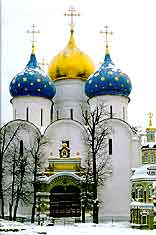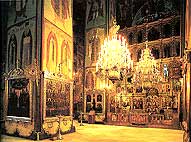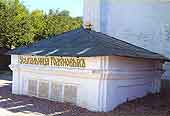 The 16th century was an important step in the Monastery architectural history. The document mentions that in the mid 16th century, when the stone walls were constructed, the territory was enlarged and rearranged. In 1559 – 1585, the Assumption Cathedral was constructed in the central square to the order of Ivan the Terrible. It repeated the shapes of the Assumption Cathedral of the Moscow Kremlin, that was the symbol of the state power. The Cathedral is monumental and severe. There are five feebly expressed apses from the east. The white surface of the walls is divided by massive vertical pilasters. They support semi-circular gables. Two rows of high narrow windows emphasize the impressively thick walls. Between them there is a decorative belt of arches and columns. The curve-linear roofing is crowned by five massive cupolas.
The 16th century was an important step in the Monastery architectural history. The document mentions that in the mid 16th century, when the stone walls were constructed, the territory was enlarged and rearranged. In 1559 – 1585, the Assumption Cathedral was constructed in the central square to the order of Ivan the Terrible. It repeated the shapes of the Assumption Cathedral of the Moscow Kremlin, that was the symbol of the state power. The Cathedral is monumental and severe. There are five feebly expressed apses from the east. The white surface of the walls is divided by massive vertical pilasters. They support semi-circular gables. Two rows of high narrow windows emphasize the impressively thick walls. Between them there is a decorative belt of arches and columns. The curve-linear roofing is crowned by five massive cupolas.
 The interior looks festive and majestic due to bright light and fine frescoes on the walls, vaults and supporting pillars. The frescoes were produced by 35 Yaroslavl and local Trinity painters, supervised by Dmitry and Grigory Plekhanov, 99 years after the construction of the Cathedral. The frescoes are narrative their colors are bright and cool. The iconostasis includes five rows of icons. The wood-carved frames are gilded. There are 76 icons of the 17th – 18th cc. in the iconostasis. The Evangelists on the Royal Doors were painted by the tsar isographer Simon Ushakov. Behind the iconostasis there are wooden three-tier choirs. Two huge copper church chandeliers of the 17th century were made by the craftsmen of the Armory Chamber of the Moscow Kremlin and presented to the Monastery by Boyar Yanov.
The interior looks festive and majestic due to bright light and fine frescoes on the walls, vaults and supporting pillars. The frescoes were produced by 35 Yaroslavl and local Trinity painters, supervised by Dmitry and Grigory Plekhanov, 99 years after the construction of the Cathedral. The frescoes are narrative their colors are bright and cool. The iconostasis includes five rows of icons. The wood-carved frames are gilded. There are 76 icons of the 17th – 18th cc. in the iconostasis. The Evangelists on the Royal Doors were painted by the tsar isographer Simon Ushakov. Behind the iconostasis there are wooden three-tier choirs. Two huge copper church chandeliers of the 17th century were made by the craftsmen of the Armory Chamber of the Moscow Kremlin and presented to the Monastery by Boyar Yanov.
As other monuments, the Cathedral was greatly changed in the course of time. Thus, in the 18th century, the curvy-linear gables were replaced by a hip roof that resulted in the superstructure of the central drum, the spherical cupolas were replaced by onion shapes, the stone parvis at the western wall was dismantled, the colorful porches appeared at three facades. ,,,,, cupola At the end of the 19th century the Crypt of All Saints was arranged under the Cathedral. It notably weakened the foundation. The changes affected the constructions. Now the Cathedral is one of the most problematic buildings requiring constant examination and necessary reinforcement works.
Godunov Vault
 Near the north-western corner of the Assumption Cathedral there is a low small tent with a hip roof . It is the vault of the 18th century. It contains the relics of Tsar Boris Godunov, his wife Maria, son Feodor and daughter Xenia, buried at the beginning of the 17th century under the parvis. The western facade, facing the central square, contains four marble stones with the names and dates in the following order:
“In the year of 7113 (1605) on the 10th of June died Feodor Borisovich, blessed tsarevich of all Russia; in the year of 7113 (1605) on the 1st of May died Boris, blessed tsar and grand prince of all Russia, monk Bogolep; in the year of 7113 (1605) on the 10th of June died Maria Grigoryevna, blessed tsarina and princess of all Russia; in the year of 7130 (1622) on the 30th of August died tsarina Olga Borisovna.
Near the north-western corner of the Assumption Cathedral there is a low small tent with a hip roof . It is the vault of the 18th century. It contains the relics of Tsar Boris Godunov, his wife Maria, son Feodor and daughter Xenia, buried at the beginning of the 17th century under the parvis. The western facade, facing the central square, contains four marble stones with the names and dates in the following order:
“In the year of 7113 (1605) on the 10th of June died Feodor Borisovich, blessed tsarevich of all Russia; in the year of 7113 (1605) on the 1st of May died Boris, blessed tsar and grand prince of all Russia, monk Bogolep; in the year of 7113 (1605) on the 10th of June died Maria Grigoryevna, blessed tsarina and princess of all Russia; in the year of 7130 (1622) on the 30th of August died tsarina Olga Borisovna.
|


